![]()
![]()
![]()
Use LEFT and RIGHT arrow keys to navigate between flashcards;
Use UP and DOWN arrow keys to flip the card;
H to show hint;
A reads text to speech;
52 Cards in this Set
- Front
- Back
- 3rd side (hint)

|
Buddha on lintel (MAHAO TOMB), Eastern Han Dynasty.
|
- Buddhist iconography: sitting posture, hands (MUDRA), halo
- Buddha-like Chinese deities (misinterpretation), interchangeable with immortals (juxtaposed with a dragon on the lintel) - Not used in Buddhist ritual |
|

|
Votive Stele with Deified Laozi, Sui Dynasty.
|
- Buddhist iconography: sitting posture, hands, halo
- Buddha thought to be interchangeable with Laozi - Not used in Buddhist ritual |
|
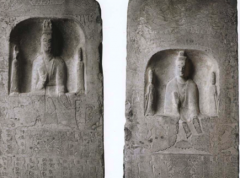
|
Stele with the Deified Laozi and Shakyamuni Buddha, Northern Wei Dynasty.
|
- Buddhist iconography: sitting posture, hands, halo
- Buddha thought to be interchangeable with Laozi: telling of Laozi's birth mirroring that of Buddha - Not used in Buddhist ritual - DAOISM in competition with BUDDHISM -Advent of Buddhism as catalyst for local ideas to congregate and organize. -Vairocana w lion or two dragons |
|

|
CAVE 18: Disciple and attending bodhisattvas, Yungang Caves. Northern Wei Dynasty.
|
- Many Buddhas on garment, implies that Buddha is beyond form and can manifest himself in multiple fashions
-Plump Buddha vs thin attendants -No emotion: Buddha transcends human feelings -Importance of PUPILS and livelihood |
|
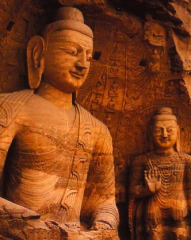
|
Yungang CAVE 20, Northern Wei Dynasty.
|
-inferring authority of buddha to emperor who commissioned it
- Zigzag pattern: allusion to first Buddha figure constructed by Indian king, MERIT MAKING - Imperially sponsored to atone the previous emperor's persecution of Buddhism - No specific kind of BUDDHA: emphasis on transferring of authority - other figure as patron?: merit making |
|
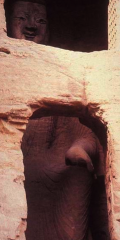
|
CAVE 19: Seated Buddha, Yungang Caves. Northern Wei Dynasty.
|
- window and strong sense of hierarchy
- Conferring images the power to actively look (and not just be SEEN) comes to represent power. - Inside 'window': emphasis on Buddha actively looking, he is alive. - PUPILS: alive - Not for GUAN ritual (not in close proximity) |
|
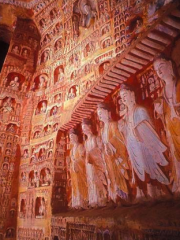
|
CAVE 11, Northern Wei Dynasty.
|
- MERIT MAKING: several 'advertisement' spaces to be purchased
- circumabulatory space - Buddhas/Emperors?: Ambiguity of this proves that the focus was on the idea of merit making rather than the actual figure of Buddha - NOT ONE CENTRAL FIGURE - Indian 'flavour': long flowing robe-- but sinicized (patrons of the state) |
|
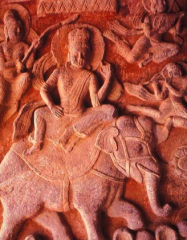
|
Yungang CAVE 9, Northern Wei Dynasty.
|
- White elephant and Buddha's conception
- Low relief: emphasis on both 2D and 3D play with dimension |
|

|
Center pillar, Yungang Caves. Northern Wei Dynasty.
|
- about circumambulation, walking
- for the external authority that rested in the kings AND the ancestors - linked to the idea of Dharma: dichotemy of the step, UP DOWN UP DOWN... transcending the simple step. Part of an external authority system |
|
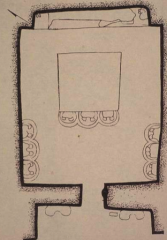
|
Plan of Dunhuang Cave, Tang Dynasty.
|
- about circumambulation, walking
- for the external authority that rested in the kings AND the ancestors - linked to the idea of Dharma: dichotemy of the step, UP DOWN UP DOWN... transcending the simple step. Part of an external authority system |
|
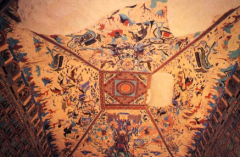
|
Thousand Buddhas and the Heavenly Realms. Northern Dynasties.
|
- seems to depict heaven (although nothing specifically buddhist)
- strong symmetry (flowing chi- circle and square and the cosmos) heaven on earth: SINICIZATION - taotie motif |
|
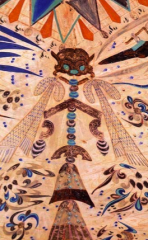
|
Monster Mask with Pendants, Western Wei Dynasty.
|
- Sinicization: Chinese taotie motif
- parallels with pupils: actively looking, power. |
|
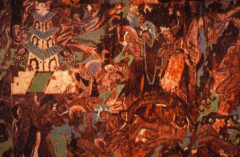
|
Jataka Tale of Prince Satta, Northern Wei Dynasty.
|
-one narrative, prince represented several times
-not sequential, merged onto a single plane - dramatic composition: not intended to be narrative but rather visual aid |
|
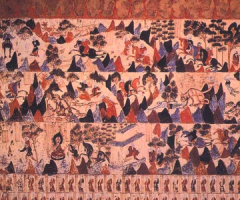
|
Jataka Tale of Prince Satta, Tang Dynasty.
|
- Linearity derives from the West (divided into registers)
- scene by scene, sequential, not a visual aid but to tell a story unto itself - attempt to give structured representations of theoretical texts |
|

|
Lotus Sutra Transformation Tableau, Sui Dynasty.
|
- Sequential (even if the text it is inspired by is not a narrative)
- Framing devices - listing of Buddhist divinites |
|
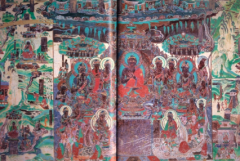
|
Lotus Sutra Transformation Tableau, Tang Dynasty.
|
- BASIC STRUCTURE OF SUTRA IS REPRESENTED: figures around as content, centre as central figures
- Spacial organization, but the deeper implication is the Buddhist idea of EXPEDIENT MEANS - top part of a sutra painting is usually reserved for the representation of a celestial realm, in this case, several pavillions are depicted instead (SINICIZATION: well wishing of the commissioner's ancestors). |
|
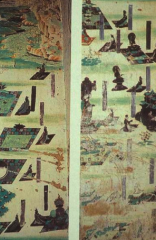
|
(Visualization Meditation) Sutra. Detail: 16 Meditations of Queen Vaidehi, Tang Dynasty.
|
- DEEP SUSPICION OF IMAGES, HOW THEY ARE FLEETING, notion of 'emptyness'-- yet image is necessary as expedient means.
- DHARMA, channel the manifestation of Buddha (EXPEDIENT MEANS) MERIT - From a part, to a whole, and then to a multitude of wholes... towards transcendence. - Enlightenment/ Process of Guan: attaining transcendence: Pure Land Buddhism |
|
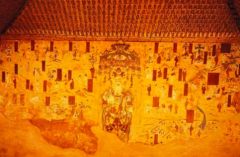
|
Manifestations of Guanyin, Dunhuang cave. Tang Dynasty.
|
- frontal representation is important (icon is thought to be living, helping through expedient means)
-Buddha as RESONANT BODY, in front of faithful -TRANSFORMATION BODY: lower form accessible to 'ordinary humans' - DHARMA BODY-EMPTINESS- IMAGES AS EXPEDIENT MEANS ... the closer you come to enlightenment the less you need them |
|

|
Ksitigarbha with 10 Kings, Hanging Scroll. Tang Dynasty.
|
- Commissioning of 10 King Script: GOOD KARMA "Logbook of Karma"
- Contrast with Confucian thought, rooted in China before the Tang Dynasty - What hell is like and why you should seek good karma - Also about what living people can do to ensure that their ancestors have a safe journey (early China) - Ksitigarbha as Boddhisatva who aids you in the afterworld - Rebirth as painful, escaping it (Pure Land Buddhism or Nirvana). |
|
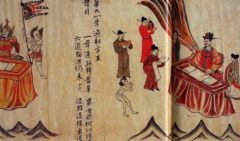
|
10 Kings of Hell, Tang Dynasty.
|
- Commissioning of 10 King Script: GOOD KARMA
- Contrast with Confucian thought, rooted in China before the Tang Dynasty - What hell is like and why you should seek good karma - Also about what living people can do to ensure that their ancestors have a safe journey (early China) - Rebirth as painful, escaping it (Pure Land Buddhism or Nirvana). |
|
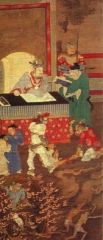
|
Jin Chushi's Workshop (10 Kings of Hell), Southern Song Dynasty.
|
- TORTURE SCENES TO SCARE: First king of hell: after 7 days
- eventually less about religious fear, and more about secular 'horror flick' - Commissioning of 10 King Script: GOOD KARMA - Contrast with Confucian thought, rooted in China before the Tang Dynasty - What hell is like and why you should seek good karma - Also about what living people can do to ensure that their ancestors have a safe journey (early China) - Rebirth as painful, escaping it (Pure Land Buddhism or Nirvana). -Images of torture gradually appear |
|
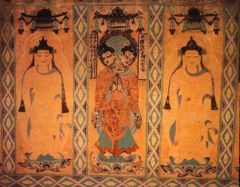
|
Auspicious Icons, Dunhuang Caves. Tang Dynasty.
|
- Believed to manifest themselves to aid others in achieving Nirvana
- Equal to Buddha, Buddha relic, etc - Parallels with Buddha manifesting himself though artist (example of first Buddha) - two headed buddha - double headed omens - (STATUES, APPARITIONS, all part of the same system). |
|
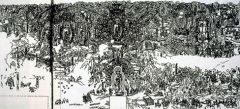
|
Story of Liu Sahe, Dunhuang Caves. Tang Dynasty.
|
- Leader does not support Buddhism (heads falling... omen
-Real Buddha above Statue, people painting miraculous icon - distinction between human copy + auspicious icon is removed, the only differentiating factor: DEGREE OF VISIBILITY. - Degree of Manifestations: (BODY HIERARCHY): Dharma, resonant (for boddhisatvas), transformation). |
|
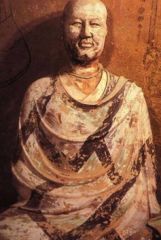
|
Portrait of Monk Hong Bian, Dunhuang Caves. Tang Dynasty.
|
The issue of the double arises in Buddhist images mostly when a portrait, skulpture, or sometimes mummified bodies functioned as "substitute bodies", i.e. not just representations but avatar figures that could act, respond, and preside over important events.
- Copies rendered realistically, but also considered to be REAL (bones, ashes, scriptures housed inside). - Drawing on the pupils - Embodiment of the teacher, replaceable - Enlightenment and the 'indestructible body' |
|

|
Set of Silver and Gold Reliquary Caskets. Tang Dynasty.
|
-Dharma and the problem of the double
- Transcendence VS emanation: synecdoche of Sakyamuni - self iconization - SYNECHDOCHE: part treated as a whole |
|
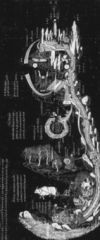
|
Illustration of Inner Circulation. Qing Dynasty.
|
- body as a complex microcosm
COSMOLOGICAL CONCERN: gods within your body, get to know them and mobilize their power - cosmic maps -system of cosmic technology: accessing deeper layers of the world - Taoism and the New Microcosm of Rulership (INNER ALCHEMY) - Daoist dichotimy of YING AND YANG and how this does not apply to theDharma body |
|

|
Huan Zhang, Diagram of the Supreme Ultimate. Ming Dynasty.
|
- New microcosm of rulership.
Taoist idea of “inner alchemy” - balance of the opposites, juxtaposition of ying and yang: entire universe - Interest in graphic forms (ie body) and so also with writing |
|
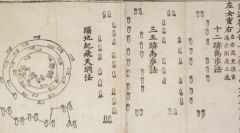
|
Miaozong Yuan, The Pace of Yu. Ming Dynasty.
|
- New microcosm of rulership (classic of the way and virtue) set of proverbs given on how to rule correctly.
- The advice was initially meant for rulers: how to govern effectively, in a manner that will ensure longevity. - The proverbs were later upgraded into divine texts (for emperor and individuals). - Dao do Jin became something that was an instructional manual for Taoist followers. (the idea of “inner alchemy” (aligning yourself with different constellations, different types of breathing, walking with the constellations), it is possible to channel the power coming from the cosmological forces for the benefit of the self AND society) - "New Bright Hall" <-> han vision of imperial order - Democratizes imperial status: each individual as emperor |
|
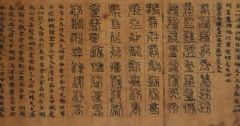
|
Great Highest Cavern Mystery..., Tang Dynasty.
|
- Divine writing (sky writing): cloud, elusive, non-fixed.
- Only advanced sages could read them and transcribe them into 'human' writing. - parallel with oracle bones: cracks and clouds as manifestations of powers, patterns, sgns. |
|
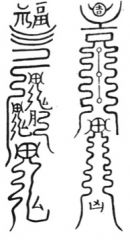
|
Charms Producing Happiness by Destruction of Specters. Qing Dynasty.
|
- Vertical direction, movement, polarity, but not linear like western writing
- characters as auspicious and inauspicious (character for devil: rendered artistically). - THE ACT OF SUBDUING THOSE ENTITIES AND REACHING THE AUSPICIOUS WHOLE - Take notion of power of writing adopts it in such a way that enhances its power and creates effects, actively making use of the power of writing - communication with spirits (juxt. with alphabets of the west) |
|

|
Uppermost Highest Spirit... Yuan Dynasty.
|
|
|

|
Stone Drums Inscriptions. Zhou Dynasty.
|
SEAL SCRIPT: fewer angles, aesthetically complicated, more strokes, shorter
o Engraved on various materials: stones, bronze etc. o Script types often correspond to particular functions o This is a rubbing of a stone inscription |
|
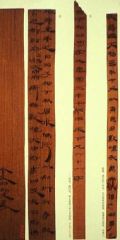
|
Juyan Han Wood Strips, Western Han Dynasty.
|
Press brush on surface to produce wide ending of long stripes
• These exaggerated strokes – especially the endings – are also found in some practice strips • Played with resistance of brush – important in how calligraphy comes about • Calligraphy is an attempt to play with resistance, surface, modulation of the stroke • Modulation becomes more subtle once those writers start to write on a more delicate surface • Bamboo = good place to start taking awareness of surface – physical sensation of surface • Once they learned that, they were able to transfer their work onto more smooth surfaces, e.g. paper |
|
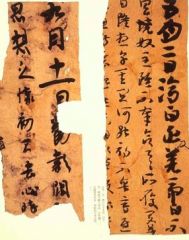
|
Loulan Jin Paper Pieces, Jin Dynasty.
|
Loulan Jin Paper Pieces 255CE, Jin Dynasty – Loulan
• Can see modulation of stroke that was developed earlier which was transposed onto the surface of the paper |
|

|
Wang Xizhi, Orchid Pavilion. Eastern Jin Dynasty.
|
This piece is one of the most celebrated works of Chinese calligraphy
• There was a gathering at the Orchid pavilion – scenic place where people made poems, and they put together these poems and he wrote a preface to the book (this is what this is) • Can see that there are a lot of different seals – legend that original was owned by Tang emperor who was so attached to it that when he died he decided to go with it – took it to his grave - Important of the SEAL |
|
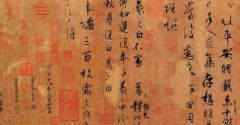
|
Wang Xizhi, Three Passages of Calligraphy. Eastern Jin Dynasty.
|
|
|
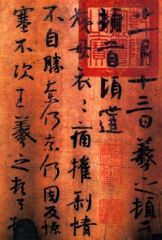
|
Wang Xizhi, Letter to an Aunt. Eastern Jin Dynasty.
|
|
|
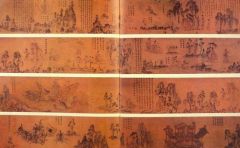
|
Gu Kaizhi, Nymph of the Luo River. Eastern Jin Dynasty (Song Dynasty Copy).
|
|
|
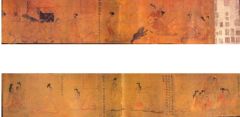
|
Gu Kaizhi, Admonitions of the Court Instructress. Eastern Jin Dynasty.
|
- writing as the frame
|
|
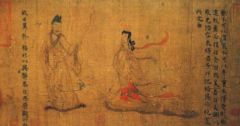
|
Gu Kaizhi, Admonitions of the Court Instructress. Eastern Jin Dynasty.
|
|
|
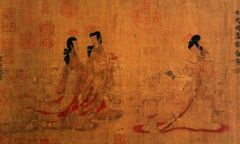
|
Gu Kaizhi, Admonitions of the Court Instructress, Eastern Jin Dynasty.
|
|
|
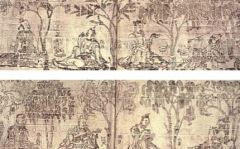
|
Seven Worthies of the Bamoo Grove, Southern Dynasties.
|
- linear flow and not visual
- flow to evoke 'qi' resilience-> state of the 'affected' - painting capturing the 'vitality' of a person -stroke capturing the chi (gu kaizhi) |
|

|
Stories of Exemplary Conduct, Northern Wei Dynasty.
|
|
|
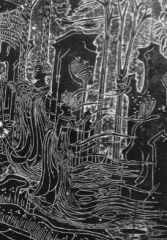
|
Engraved Stone Sarcophagus, Northern Wei Dynasty.
|
|
|
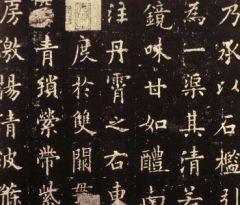
|
Ouyang Zun, Inscription of the Palace of Ninefold Perfection. Tang Dynasty.
|
- perfection of form, perfection of order
- independent operations and 'fixed centre' (lack of linearity) |
|

|
Chu Suiliang Preface to the Sacred Teaching Stele. Tang Dynasty.
|
-more strokes, differences in strokes: minimal, no longer about momentum
-marks beginning, traces middle, marks end (system of threes), repeated structure - independent operations and 'fixed centre' (lack of linearity) |
|

|
Wang Xizhi, Memorial on an Announcement... Eastern Jin Dynasty.
|
- calligraphy sets the parameters for painting, meaning comes from centre of the character, something physical is produced (IMPORTANCE OF THE SEAL)
-I PI: emphasis on calligrapher's gesture, gestural juxtaposition of OU-YANG HSUN. ying and yang - or bouncing by canceling (Goldberg reading): YU SHIN-NAN |
|

|
Yan Zhenqing, Draft Manuscript of a Memorial to his Nephew... Tang Dynasty.
|
|
|
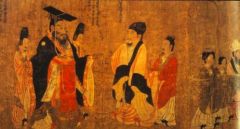
|
Yan Liben, Emperors of the Successive Dynasties. Tang Dynasty.
|
- OUTER COURT: didactic in nature, what to do and what not to
-MORAL DIDACTICISM, what is good vs what is evil - one emperor as 'bad': hairy, silly head gear, reflecting his character: MEAN EYES |
|

|
Zhou Fang, Ladies Wearing Flowers in their Hair. Tang Dynasty.
|
INNER COURT: where imperial desire is articulated
- sensitivity to gaze, desire - very little background deco - not gazing back, on display for the emperor? - INVITES THE VIEWER |
|

|
Gu Hongzhong, Night Revels of Han Xizai. Five Dynasties.
|
- "qi" in blankets, gestures, thinness
- GAZE: dotting the eyes, coming alive - Taoist theology: behind the eyebrow - Much like OU-YANG HSUN'S vision of the counterstroke: THE GAZES - bracketing: hsiang PAINTING CAN SOMETIMES BE SEEN AS "ONE BIG CHARACTER" Gaze and stroke and bed as brackets |
|

|
Zhou Wenju, Double Screen. Five Dynasties.
|
- screen within the screen: doubling of space
-OUTSIDE (public) and INSIDE (private, intimate) themes. - screen is not treated as a flat pic, but invites the viewer into the space.. in a less erotic way - pairing /symmetry (complex 2d-> 3d) |

